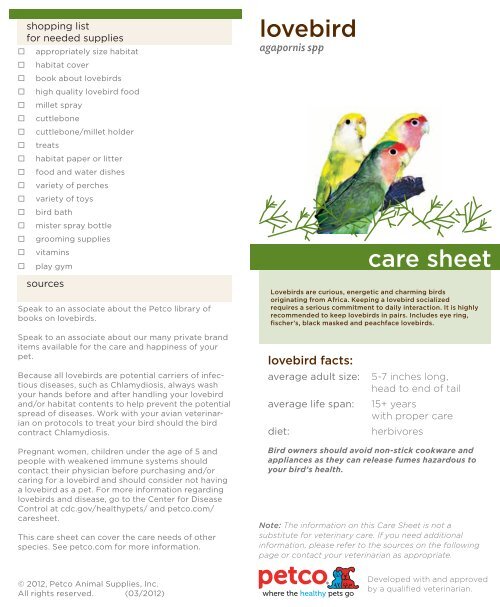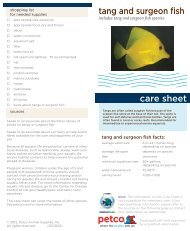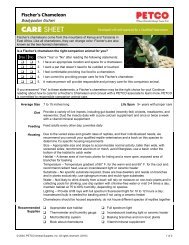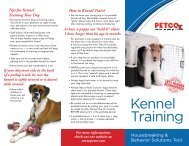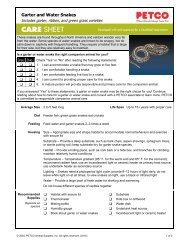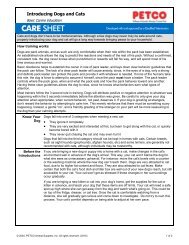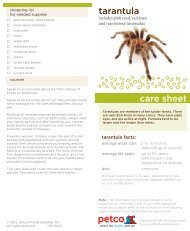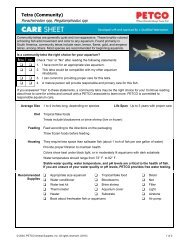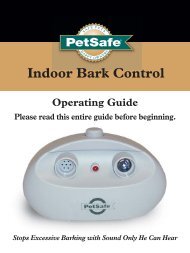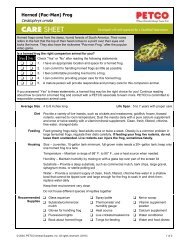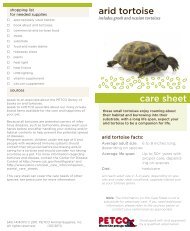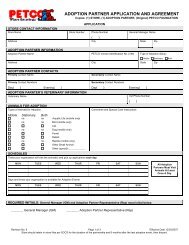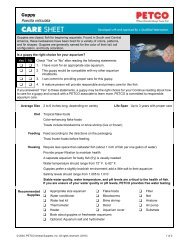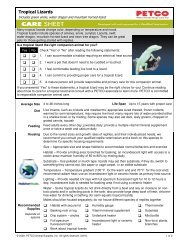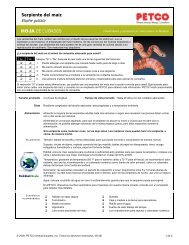lovebird care sheet - Petco
lovebird care sheet - Petco
lovebird care sheet - Petco
You also want an ePaper? Increase the reach of your titles
YUMPU automatically turns print PDFs into web optimized ePapers that Google loves.
shopping list<br />
for needed supplies<br />
appropriately size habitat<br />
habitat cover<br />
book about <strong>lovebird</strong>s<br />
high quality <strong>lovebird</strong> food<br />
millet spray<br />
cuttlebone<br />
cuttlebone/millet holder<br />
treats<br />
habitat paper or litter<br />
food and water dishes<br />
variety of perches<br />
variety of toys<br />
bird bath<br />
mister spray bottle<br />
grooming supplies<br />
vitamins<br />
play gym<br />
sources<br />
Speak to an associate about the <strong>Petco</strong> library of<br />
books on <strong>lovebird</strong>s.<br />
Speak to an associate about our many private brand<br />
items available for the <strong>care</strong> and happiness of your<br />
pet.<br />
Because all <strong>lovebird</strong>s are potential carriers of infectious<br />
diseases, such as Chlamydiosis, always wash<br />
your hands before and after handling your <strong>lovebird</strong><br />
and/or habitat contents to help prevent the potential<br />
spread of diseases. Work with your avian veterinarian<br />
on protocols to treat your bird should the bird<br />
contract Chlamydiosis.<br />
Pregnant women, children under the age of 5 and<br />
people with weakened immune systems should<br />
contact their physician before purchasing and/or<br />
caring for a <strong>lovebird</strong> and should consider not having<br />
a <strong>lovebird</strong> as a pet. For more information regarding<br />
<strong>lovebird</strong>s and disease, go to the Center for Disease<br />
Control at cdc.gov/healthypets/ and petco.com/<br />
<strong>care</strong><strong>sheet</strong>.<br />
This <strong>care</strong> <strong>sheet</strong> can cover the <strong>care</strong> needs of other<br />
species. See petco.com for more information.<br />
© 2012, <strong>Petco</strong> Animal Supplies, Inc.<br />
All rights reserved. (03/2012)<br />
<strong>lovebird</strong><br />
agapornis spp<br />
<strong>care</strong> <strong>sheet</strong><br />
Lovebirds are curious, energetic and charming birds<br />
originating from Africa. Keeping a <strong>lovebird</strong> socialized<br />
requires a serious commitment to daily interaction. It is highly<br />
recommended to keep <strong>lovebird</strong>s in pairs. Includes eye ring,<br />
fischer’s, black masked and peachface <strong>lovebird</strong>s.<br />
<strong>lovebird</strong> facts:<br />
average adult size: 5-7 inches long,<br />
head to end of tail<br />
average life span: 15+ years<br />
with proper <strong>care</strong><br />
diet: herbivores<br />
Bird owners should avoid non-stick cookware and<br />
appliances as they can release fumes hazardous to<br />
your bird’s health.<br />
Note: The information on this Care Sheet is not a<br />
substitute for veterinary <strong>care</strong>. If you need additional<br />
information, please refer to the sources on the following<br />
page or contact your veterinarian as appropriate.<br />
Developed with and approved<br />
by a qualified veterinarian.
<strong>care</strong> <strong>sheet</strong><br />
diet<br />
A well-balanced <strong>lovebird</strong> diet<br />
consists of:<br />
• Specialized pellets should<br />
make up 60-70% of diet, fresh<br />
vegetables and fruits and small<br />
amounts of fortified seeds<br />
• Clean, fresh, filtered, chlorinefree<br />
water, changed daily.<br />
• Do not feed birds avocado,<br />
fruit seeds, chocolate, caffeine<br />
or alcohol as these can cause<br />
serious medical conditions.<br />
Avoid sugar and high fat treats.<br />
feeding<br />
Things to remember when feeding<br />
your <strong>lovebird</strong>:<br />
• Fresh food and water should<br />
always be available.<br />
• Vegetables and fruits not eaten<br />
within a few hours should be<br />
discarded.<br />
• Remember, treats should not<br />
exceed 10% of total food intake.<br />
housing<br />
• Lovebirds acclimate well<br />
to average household<br />
temperatures, not to exceed<br />
80°F; be cautious of extreme<br />
red flags<br />
• beak swelling or<br />
accumulations<br />
• fluffed, plucked, or<br />
soiled feathers<br />
• sitting on floor of<br />
habitat<br />
• wheezing or coughing<br />
<strong>lovebird</strong><br />
agapornis spp<br />
temperature changes. The<br />
habitat should be placed off the<br />
floor in an area that is well-lit<br />
and away from drafts.<br />
• A habitat approximately 18”W<br />
x 18”D x 24”H, with metal bars<br />
spaced no greater than 3/8”<br />
apart, makes a good home for a<br />
pair of <strong>lovebird</strong>s; a flight habitat<br />
is strongly recommended. It<br />
is best to provide the largest<br />
habitat possible.<br />
• Perches should be at least<br />
4” long and 1/2” in diameter;<br />
a variety of perch sizes to<br />
exercise feet and help prevent<br />
arthritis is recommended.<br />
• A metal grate over the<br />
droppings tray will keep the<br />
bird away from droppings; line<br />
the droppings tray with habitat<br />
paper or appropriate substrate<br />
for easier cleaning. To avoid<br />
contamination, do not place<br />
food or water containers under<br />
perches.<br />
• Lovebirds can be kept alone<br />
to bond with pet parent or in<br />
pairs to bond with each other.<br />
Different types of birds should<br />
not be housed together.<br />
• Birds should be socialized daily<br />
by the pet parent.<br />
• runny or discolored<br />
stools<br />
• favoring one foot<br />
• eye or nasal discharge<br />
• red or swollen eyes<br />
• loss of appetite<br />
If you notice any of these signs, please contact your<br />
exotic animal veterinarian.<br />
normal<br />
behavior<br />
• Single <strong>lovebird</strong>s bond best with<br />
owners, but keep in pairs if you<br />
cannot devote enough daily<br />
interaction time.<br />
• Love to chew, so ensure plenty<br />
of toys to chew on.<br />
• They can be territorial, have a<br />
unique chatter and a naturally<br />
loud call.<br />
• Provide foraging toys, which<br />
provide important mental<br />
stimulation.<br />
habitat<br />
maintenance<br />
• Clean and disinfect the habitat<br />
and perches regularly<br />
• Replace substrate or habitat<br />
liner weekly or more often as<br />
needed.<br />
• Replace perches, dishes, and<br />
toys when worn or damaged;<br />
rotate new toys into the habitat<br />
regularly.<br />
• Ensure that there are no<br />
habitat parts or toys with lead,<br />
zinc or lead-based paints or<br />
galvanized parts as these can<br />
cause serious medical issues if<br />
ingested by your bird.<br />
• Do not use a lot of cleaning<br />
common health issues<br />
Developed with and approved<br />
by a qualified veterinarian.<br />
agents around your bird as<br />
the fumes can be harmful. It is<br />
recommended to use a natural<br />
cleaning product.<br />
grooming<br />
& hygiene<br />
• Lovebirds love to take baths, so<br />
at least twice weekly provide<br />
filtered, chlorine-free, lukewarm<br />
water for bathing; remove<br />
the water when done. As an<br />
alternative, mist the bird with<br />
water.<br />
• Clipping flight feathers is not<br />
necessary, but when done<br />
correctly it can help prevent<br />
injury or escape; consult an<br />
avian veterinarian on what is<br />
best for your bird.<br />
• Nails should be trimmed by<br />
a qualified person to prevent<br />
injury to the bird.<br />
signs of a<br />
healthy animal<br />
• Active, alert, and sociable<br />
• Eats and drinks throughout<br />
the day<br />
• Dry nares and bright, dry eyes<br />
• Beak, legs and feet normal in<br />
appearance<br />
• Clean, dry vent<br />
• Smooth, well-groomed feathers<br />
Health Issue Symptoms or Causes Suggested Action<br />
chlamydiosis appetite loss, fluffed feathers, seek immediate avian<br />
nasal discharge.<br />
veterinary attention.<br />
diarrhea fecal portion of stool not consult with an avian<br />
formed. Multiple causes, from veterinarian and<br />
change in diet to internal<br />
parasites.<br />
ensure proper diet.<br />
feather bird plucks own feathers. consult with an avian<br />
plucking<br />
veterinarian and<br />
relieve boredom with<br />
attention, new toys,<br />
or space.<br />
avian pox lesions in mouth, scabs on seek immediate avian<br />
eyes and face.<br />
veterinary attention.<br />
psittacine beak abnormal feather color,<br />
and feather<br />
disease<br />
feather loss, beak deformities.


